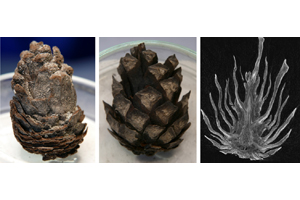Conifer cones bear their ages well, and still move it

Photographs of the Keteleeria sp. (left) and Pinus sp. 1 (middle) cones investigated in the study, and an x-ray-computed tomography image of the Pinus sp. 2 cone (right). Photos: © Plant Biomechanics Group
Fossil conifer cones can still move their individual seed scales after millions of years. This is the finding of a study conducted by the biologists Dr. Simon Poppinga and Prof. Dr. Thomas Speck from the Plant Biomechanics Group and Botanical Garden of the University of Freiburg.
The cones analyzed in the study therefore represent the oldest known plant structures that are still capable of movement and can also serve as a model for bioinspired technical applications with low maintenance requirements. The researchers published their findings in the journal Scientific Reports.
Cones from coniferous trees like pines open in response to dry conditions and close in response to wet conditions – a mechanism that enables them to release their seeds under favorable environmental conditions. In addition, the movement of the individual scales is passive, meaning that it does not require any metabolic energy.
These attributes have recently brought conifer cones to the attention of scientists, who aim to use them as biological models for the development of technical devices capable of autonomous movement. Poppinga and Speck have now discovered that the scales continue to function in this way for an extremely long time: Fossil cones from the Eemian interglacial period, about 126,000 to 113,000 years ago, as well as the middle Miocene, about 16.5 to 11.5 million years ago, still react to changes in moisture by moving their scales.
With the help of x-ray-computed tomography, the researchers demonstrated that the cones are preserved by coalification during the fossilization process and that the fossilized cones show only very few mineral inclusions. This ensures that the fine structures responsible for moisture-dependent movement remain intact.
The study was conducted within the scope of the European research network JONAS (Joint Research Network on Advanced Materials and Systems). Besides Poppinga and Speck, scientists from BASF SE and Heidelberg University Hospital also collaborated on the study.
Original publication:
S. Poppinga, N. Nestle, A. Šandor, B. Reible, T. Masselter, B. Bruchman, T. Speck (2016). Hygroscopic motions of fossil conifer cones. In: Scientific Reports 7:40302, DOI: 10.1038/srep40302
Contact:
Prof. Dr. Thomas Speck
Plant Biomechanics Group / Botanical Garden
University of Freiburg
Phone: +49 (0)761/203-2875
E-Mail: thomas.speck@biologie.uni-freiburg.de
https://www.pr.uni-freiburg.de/pm/2017/pm.2017-01-11.2-en?set_language=en
Media Contact
All latest news from the category: Life Sciences and Chemistry
Articles and reports from the Life Sciences and chemistry area deal with applied and basic research into modern biology, chemistry and human medicine.
Valuable information can be found on a range of life sciences fields including bacteriology, biochemistry, bionics, bioinformatics, biophysics, biotechnology, genetics, geobotany, human biology, marine biology, microbiology, molecular biology, cellular biology, zoology, bioinorganic chemistry, microchemistry and environmental chemistry.
Newest articles

First-of-its-kind study uses remote sensing to monitor plastic debris in rivers and lakes
Remote sensing creates a cost-effective solution to monitoring plastic pollution. A first-of-its-kind study from researchers at the University of Minnesota Twin Cities shows how remote sensing can help monitor and…

Laser-based artificial neuron mimics nerve cell functions at lightning speed
With a processing speed a billion times faster than nature, chip-based laser neuron could help advance AI tasks such as pattern recognition and sequence prediction. Researchers have developed a laser-based…

Optimising the processing of plastic waste
Just one look in the yellow bin reveals a colourful jumble of different types of plastic. However, the purer and more uniform plastic waste is, the easier it is to…



